Bonsai Techniques
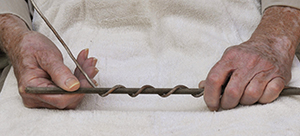
Wiring
by Lew Buller
Anodized aluminum wire is used on deciduous and thick-barked trees. It is less expensive and more easily available than copper wire. I used it until I learned to use copper wire and then used that almost exclusively.
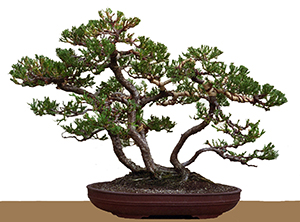
The Juniperus horizontalis or creeping juniper is a low-growing prostrate form of juniper, not low enough to be called ground cover and not tall enough to be a shrub. According to Wikipedia, it is native to North America, coming south only as far as northern Illinois. It defies Wikipedia and grows very well as far south as San Diego, CA. Colloquially, it is known as prostrata but it is not the only form of prostrate juniper.
Stan Childs, one of the best bonsai artists in Southern California, shaped this tree and sold it to me for $125. Although the bonsai club had shows twice a year, I never showed this tree because I did not develop it. I have had it for at least 18-20 years and it has fallen into disrepair. It needs trimming, wiring, and an application of fresh soil to allow freer passage of water.
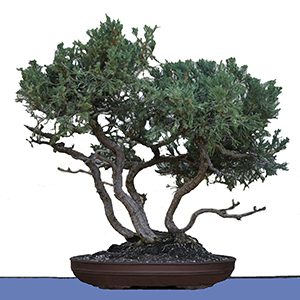
Normally we remove down-hanging new growth from branches because it will die from lack of sun. The low right-hand branch was very weak for that reason. It was no surprise to see it dead in the photo of the neglected tree. What was a surprise was the dead left trunk. A close-up photo of the base of that trunk provides an explanation. This was a prostrate creeping tree; To make it into a vertical tree, Stan had to bend the five trunks up and in the process break them apart.
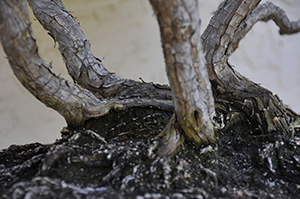
Not all of the damage is visible; some of it is hidden behind the apparently healed over base of the left branch. In addition, the left side of the left branch was split again to create a root for that branch. Why didn’t it die then? Until the five trunks were well established, the tree was connected to its original roots and they provided the nutrients and water necessary to keep the five branches alive.
The plan for this tree is simple. Cut off the two dead branches, trim the top back and wire it, and then transplant it. Wiring starts with a sharp pair of scissors. I use them to remove growth at forks, weak twigs, stubs and protrusions that will keep the wire from lying flat against the branch. Starting at the bottom and working up I trim as much as is safe; some branches may need to be left alone to grow more. If I cut more than 40% of the mature foliage off, it will revert to the juvenile stage. Wiring slows the movement of water, nutrients, and carbohydrates; a fully wired tree does not have the vigor to throw juvenile foliage. This tree is going to be wired substantially.

Anodized aluminum wire is used on deciduous and thick-barked trees. It is less expensive and more easily available than copper wire. I used it until I learned to use copper wire and then used that almost exclusively. I continue to use aluminum wire in teaching. To be most effective, wire should be applied in spirals with each turn at 45° from the previous turn; over 60° reduces holding power. I didn’t want to practice on my good trees, so I started by using a dowel or branches from trees in the ground.
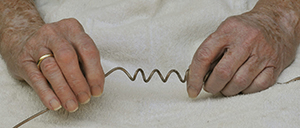
You can take the wire off, straighten it a little and use it again. Unwire it in the opposite direction as it was applied and it will be fairly straight. It should be applied by rolling the wrist of the hand holding the free end of the wire with the other hand holding the last coil made. Once you can apply it well on the dowel, try making a spiral without the dowel. I did not cheat; that coil was made without a dowel, just free-hand based on many years of wiring. Do not use a branch as a fulcrum against which to bend the wire! Damage done while wiring may cause worse wire marks than the wire itself.
Aluminum wire can be removed carefully from a branch and straightened by holding both ends of the wire with pliers and pulling the pliers strongly away from one another. It can then be re-used. Copper wire other than very small wire should be cut off with a wire cutter and saved for recycling. Pulling copper wire straight hardens it further and it must be annealed again before it can be re-used. The sizes of both kinds of wires are expressed in numbers and sold that way.
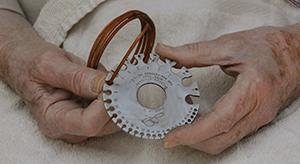
You can use a wire gauge to determine size, but after while, you will just evaluate the size of wire needed by looking at the diameter of the branch to be wired. The wire should be 1/6 th to 1/3 rd the diameter of the branch.
Annealed copper wire is used on conifers like the prostrata that are not so susceptible to wire marking and whose rate of growth is so slow the wire can be left on a long period. Know your tree; some trees wire mark worse than others. As you clean the tree with scissors, evaluate the branches and make tentative decisions about the way they should be wired.
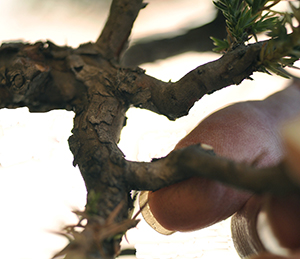
Start with the bottom branches and work up. Then follow with the next layer of branches, making sure sun can reach the bottom branches. General rule: if you want to bend branches down, start with the wire over the branch. If you want to bend branches up, start with the wire under the branch. Look at the next photo and you will know immediately which way I intend to bend the unseen branch tips.
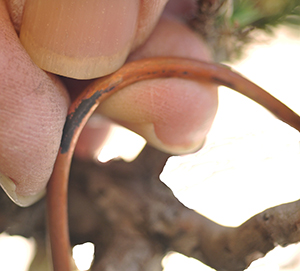
This branch will be used to show a number of steps in wiring. The wire was cut about 1/3 rd longer than the total length of the two branches together. To go around a trunk requires extra wire. After seeing the photo with the wire I started to use, I decided to use a smaller size wire. The wire first shown is 8 gauge; the wire actually used is 10 gauge. (Remember, the bigger the number, the smaller the wire. 24 gauge is the finest I use. Twigs should not be wired all the way to the very end; the tip should be free for unfettered growth.)
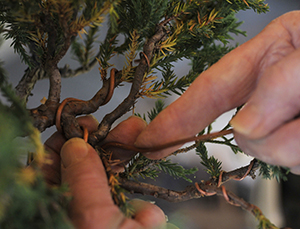
One hand holds the last coil added and the index finger of the other hand is used to make another wire coil. Holding the wire with the index finger allows precision in wrapping the coils. It also makes it easier to roll the wrist over to bend the wire rather than using the branch as a fulcrum. Think about rolling your wrist every time you wire. The 10 gauge wire is continued on out until it reaches the fork where smaller wire will be used. The end is brought up in the fork where it serves as an anchor for the 12 gauge wire used on the smaller branches.
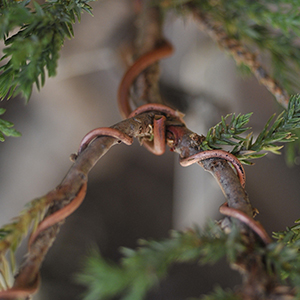
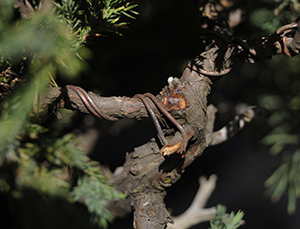
I left this stub to show another way of anchoring a wire and using it for dual purposes, wiring a strong branch and wiring two smaller branches with the same piece of wire. Measure the amount of wire needed to go from the trunk to the end of the longer of the two smaller branches, add the usual 1/3rd, then double it and cut one piece of wire. Bend the wire together, but leaving it far enough apart at the bend to go over the stub. Put the wire over the stub and holding the two sides tightly together, start wrapping the large branch as if you had one wire in your hand. Wire all the way out to the fork of the smaller branches and then separate the wires, using one piece for each small branch. Wire them out to the point you want, cut off any extra, and shape the two branches, large and small, to fit with your design. If I had not left the stub for this photo, I could have wrapped the wire around the trunk, put the two ends together, and proceeded to wire.
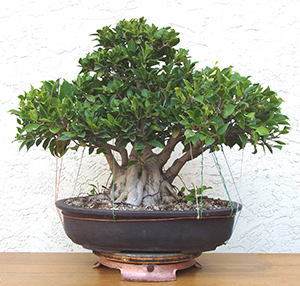
I use wire to tie down branches and leave it on until the branches are set. The end going around the branch of the ficus macrophylla is covered with 1/8th inch drip irrigation tubing to protect the bark. The other end is tied to the heavy copper wire just under the rim of the pot, or to hooks set in the wire holes in the bottom of the pot.
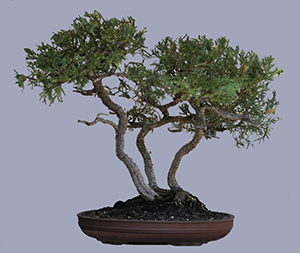
This is the final result of several hours of wiring. Now all it needs is to be fed, watered, and allowed to recover. For at least two years.
